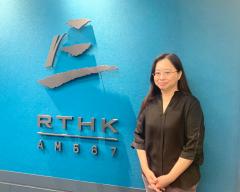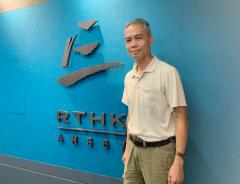簡介
Listen to #Hashtag Hong Kong every Sunday morning at 8.15
Focussing on issues affecting civil society, we'll hear from representatives of NGOs, associations, statutory bodies, and non-profit groups.
(Sundays 8.15am - 8.25am)
最新

Chris Leung, Social Worker, The Lok Sin Tong Benevolent Society
Hi everyone, I am Chris, the Deputy Centre-in-Charge of the Sham Shui PO Community Living Room of the Lok Sin Tong Benevolent Society, Kowloon.
According to the "Long-Term Housing Strategy - Annual Progress Report 2022," the government has secured sufficient land to build public housing units, fulfilling the supply targets for the next ten years. However, as the allocation of land for housing is not evenly distributed annually, only about one-third of these units will be completed in the first five-year period.
Hong Kong nowadays is facing a housing shortage, and many citizens would choose to live in subdivided flats. According to statistics released by the Census and Statistics Department in 2021, there are approximately 108,200 subdivided units for rent in Hong Kong, with an average of 3-4 partitioned rooms per unit. The median living space per person is only 56.5 sq. ft., lower than the 75 sq. ft. standard for public housing and the 161.5 sq. ft. for the average household in Hong Kong.
Apart from limited living spaces, subdivided units are also facing several problems like heavy water and electricity charges, safety issues, etc. The poor living environment has poses impacts on residents’ physical and mental health that most of them have to bear heavy financial burden and parenting.
In view of that, the Social Welfare Department (the "SWD") launched the "Community Living Room Pilot Scheme" funded by the Community Care Fund. The Sham Shui Po Community Living Room Project locates in Fuk Wa Street, Sham Shui Po, in where subdivided housing is concentrated. The Project focuses on supporting subdivided unit households, especially those with children, in order to alleviate the difficulties they face while waiting for public housing and living in poor conditions, and provide critical support during the transition period.
As a Government, Business, and Community tripartite collaboration project, the government has appointed THE LOK SIN TONG BENEVOLENT SOCIETY, KOWLOON, as the approved service organization to operate the Project, providing shared living spaces including pantry, dining room, living room, study and activity room, children's play facilities, fitness facilities, and self-service laundry facilities, as well as providing community information, health talks, After-school Learning and Support Programmes, community support and referral services. The Sham Shui Po Community Living Room has commenced operation since December 2023. It will operate for a period of three years. With the support of various sectors, the Project has already recruited over 500 families to provide them with services.
In this cross-sectoral collaboration project, not only could the users enjoy additional living space, but they could also broaden their social networks, thereby improving their quality of life and increasing their sense of community belonging. The after-school study support, provided by the Community Living Room, is aimed at alleviating pressure on parents to supervise their children’s homework. The project not only relieves the onus on parents as caretakers; it also lightens their housekeeping workload. Living in a relatively small and crowded flat, most of the users do not have space at home for a washing machine and need to wash clothes by hand. Now, however, they are able to make use of laundry services in the Community Living Room, which are available at an affordable price. User can build up their social network in the Community Living Room as well.
We will continue to actively expand the scope of services, and strive to help the sub-divided unit households in the Sham Shui Po district to improve their living space, sense of community belonging, and social networks after using the community living room facilities. In the long run, to elevate the living standards and enhance community belonging of grassroots citizens, we believe that with the participation of the business sector in setting up more Community Living Rooms in districts clustered with subdivided unit households, more grassroots families will benefit.
Three community living room projects in To Kwa Wan, Hung Hom and Nam Cheong are expected to commence operations gradually to provide support for subdivided unit households, particularly those with children. These four community living rooms are expected to serve 1,750 subdivided households, encompassing a population of around 270,000 individuals each year, to provide a better living standards for the residents.
And now I have a song I'd like to dedicate to all of you listening. My song is: "陪著你走” by Rubber Band
重溫
Leanne Tam, Campaigner, Greenpeace East Asia
I am Leanne Tam from Greenpeace East Asia.
Every day, Hong Kong people rush through work, afraid of losing to others only one tiny step behind. Takeaway coffee for breakfast and fast food takeaways to fight for more time to work? Without realizing it, this lifestyle eats us up. If you ever take a step back, you'll notice our environment is filled with rubbish. In 2021,The average daily quantity of solid waste disposed of at landfills was over 11,000 tonnes, a 18 percent increase compared to 10 years ago. The daily per capita was 1.53kg in 2021. It is definitely a number 1 compared to other East Asia well developed cities, like Taipei, Tokyo, and Seoul, where their per capita waste disposal rate is around or less than 1kg.
Taipei, Tokyo and Seoul all had implemented a waste charging scheme in their city years ago. While for Hong Kong, the municipal solid waste charging had been “discussed” for 17 years, the policy will finally be in place on 1st April next year.
The year 2024 is a critical year in making substantial progress in addressing the waste crisis in the city. Other than waste charging, the first phase on the regulation of disposable plastic tableware will also be executed in April 2024. There will be a full ban on foam food containers and cutlery, no more disposable plastic tableware allowed for dine-in restaurants and no more plastic-straw, cutlery for takeaway.
While waste charging and regulation on plastic tableware would probably be two crucial policies driving forces on waste reduction. But back to the basics, paying money while continuously throwing away disposable items doesn't mean solving the waste problem. Waste that ends up in landfills, burned in the air, or leaks into the natural environment still generates harmful chemicals and greenhouse gasses and environmental pollution. Most importantly, pollution does not happen when you throw, but it begins at the production stage of the single-use items. From oil extraction to plastic manufacturing and packaging, they have already consumed various environmental resources and caused pollution. Reducing waste at source is the root cause solution that truly tackles the waste problem.
Take a look at policies in other countries and regions, using regulation and incentive promoting REUSE to completely phase out single-use items is paramount important. To avoid the issue of simply shifting from plastic to paper, bamboo, or other single-use materials without effectively addressing the waste problem.
Greenpeace believes phasing out the unnecessary packaging is the key. For primary packaging, we can make good use of technology and product design to establish a circular packaging system. This can be achieved by implementing a reusable and returnable packaging to phase out the linear single-use packaging system. To demonstrate the possibility and feasibility of the reuse system, Greenpeace launched the Borrow and Return Cup Program in 2022, enabling customers to borrow reuse cups from over 35 cafes. Reuse cup is introduced to the Hong Kong community through a mobile app. Customers can order takeaway coffee in a reuse cup, and return the cup to any partnering cafe within the network. The program so far saved over 8,000 disposable cups, with a return rate of 99%. Not only receiving positive feedback from the F & B sector and customers, also demonstrating that environmental-friendly and convenience are not mutually exclusive.
To further reveal the environmental potential of reuse systems through scientific research, Greenpeace conducted a Life-cycle assessment of single-use and reuse cup systems. The assessment aimed to calculate the environmental impact generated throughout the entire life cycle of these cups, from production, transportation, use to final disposal.
The study found that the production stage of disposable cup systems accounts for the lion's share of emissions. Even using recycled plastic as raw material input for disposable plastic cups cannot change the significantly large amounts of natural resources consumed and the array of adverse emissions caused during the production process.
This study proved that reuse cups are more resource-efficient and cause less pollution, compared to paper cups and recycled plastic cups. Greenpeace invites chain restaurants in Hong Kong to implement reuse systems, to shoulder corporate responsibility and proactively address the second phase of disposable plastic tableware regulations. The government should also relocate more resources on reuse rather than solely relying on recycling as the ultimate solution to the waste issue. Let’s join hands and unlock the environmental potential of reuse systems, working together to make our city greener for a sustainable future.
Now I’d like to dedicate this song Fix you by Coldplay to all of you.



















